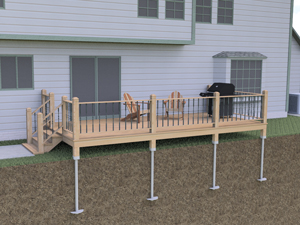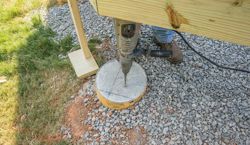From Concept to Concrete: The Important Function of Deck Footings in Sturdy and Safe Decks
Picking the Right Deck Footings for Stability and Longevity
The long life and security of your deck depend heavily on the type of footings you select, as they provide the crucial assistance and security to stand up to the examination of time. In this discussion, we will explore the various types of deck grounds, consider the essential variables to evaluate when making a choice, and dive into the pros and cons of different choices.
Sorts Of Deck Grounds
There are numerous kinds of deck footings that can be used, each offering special benefits and considerations. One typical sort of ground is the concrete pier ground. These grounds include a cylindrical hole loaded with concrete, which supplies a strong structure for the deck messages. Concrete pier grounds are reasonably very easy to mount and supply outstanding security, making them a preferred choice for many deck projects.
These footings are mounted by screwing them right into the ground, which produces a protected structure for the deck. They additionally enable for easy adjustment and progressing of the deck if required.
Conversely, some building contractors choose precast concrete grounds. These grounds are made of durable concrete and can be found in different sizes and shapes to suit different deck designs. Precast concrete footings are hassle-free to mount and offer a secure base for the deck framework.
Finally, an additional alternative is the post-in-anchor footing system. This sort of ground entails driving a metal anchor into the ground and connecting it to the deck message. It offers adaptability in terms of placing the deck blog posts and is ideal for decks with light-weight structures.
When choosing the best kind of deck ground, it is vital to consider aspects such as dirt problems, deck load, and local building codes (Deck Footings). Consulting with an expert specialist or architectural engineer can help guarantee the ideal ground is selected for a safe and steady deck
Factors to Take Into Consideration When Picking Grounds
When selecting the proper grounds for a deck, it is vital to meticulously consider various elements such as soil problems, deck load, and adherence to neighborhood structure codes. These factors play a significant role in guaranteeing the security and longevity of the deck structure.
The kind of dirt on which the deck will certainly be built establishes the kind of grounds required. On the various other hand, decks built on clay or large soils might require footings that can fit the dirt's tendency to increase and contract.
One more crucial aspect is the deck tons. The weight of the deck, including the products utilized and any type of possible real-time loads such as furnishings or gatherings, should be considered when selecting footings. The footings must be made to birth the weight of the deck and distribute it evenly to avoid any structural concerns or failures.
Lastly, adherence to local building ordinance is paramount. Building ordinance vary from area to region, and it is important to comply with the specific needs set by the neighborhood authorities. Deck Footings. These codes guarantee that the deck is developed securely and satisfies the necessary criteria for structural integrity and load-bearing ability
Concrete Footings: Disadvantages and pros

Concrete grounds provide several advantages and negative aspects when utilized as the structure for a deck. On the positive side, concrete grounds offer outstanding security and toughness.
One more advantage of concrete footings is their adaptability. They can be poured right into various sizes and shapes to fit different deck layouts and setups. Concrete footings can be personalized to fit the details needs and requirements of about his the deck framework.
Nonetheless, there are additionally some disadvantages to making use of concrete grounds. This can enhance the overall expense of the deck task and might need professional assistance.

Helical Piers Vs. Sonotubes: Which Is Much better?
In taking into consideration the foundation alternatives for a deck, the contrast in between helical piers and sonotubes is important in identifying the remarkable option. Helical piers, also recognized as screw stacks, are steel shafts with helical plates affixed to them. They are turned into the ground using hydraulic machinery, giving a durable and steady structure for the deck. On the other hand, sonotubes are cylindrical kinds made of cardboard or fiber material that are full of concrete. They are placed in an opening dug into the ground and give support for the deck.
The helical plates on the piers produce a strong grip with the soil, changing or protecting against any type of movement of the deck. Sonotubes, on the other hand, count only on the concrete loading for security, which might not use the exact same degree of stamina and resistance.
In regards to setup, helical piers are reasonably much easier and faster to mount compared to sonotubes. The hydraulic machinery utilized to twist the piers right into the ground makes certain a quick and reliable process. Sonotubes, on the other hand, call for his response digging holes and putting concrete, which can be labor-intensive and time-consuming.
Furthermore, helical piers are a more versatile choice. If needed, they can be made use of in different dirt problems and can be adjusted or enhanced. Sonotubes, on the other hand, may need added support, such as rebar, in certain dirt problems or locations with high lots needs.
Picking the Right Footings for Your Deck's Measurements
For optimal architectural integrity, it is important to carefully choose the proper grounds that line up with the measurements of your deck. The measurements of your deck, including its size, length, and elevation, play a considerable function in establishing the kind and size of grounds needed.
When picking grounds for your deck, it is very important to consider the load-bearing capacity of the soil. The weight of Discover More the deck, combined with the weight of any furniture or people on it, exerts a significant force on the grounds (Deck Footings). For that reason, it is vital to select grounds that can adequately support this weight without shifting or sinking in time.
Bigger decks with greater dimensions call for bigger footings to offer sufficient security and support. The shape of the footings, whether they are square or round, depends on the design and format of the deck.
Verdict
In verdict, picking the best deck footings is crucial for ensuring stability and resilience. Factors such as the kind of footings, the deck's measurements, and the pros and disadvantages of different choices need to be thought about.
These grounds are composed of a round hole filled with concrete, which supplies a solid structure for the deck blog posts. Concrete pier footings are relatively easy to install and supply superb stability, making them a prominent selection for numerous deck tasks.
Precast concrete grounds are hassle-free to mount and offer a steady base for the deck framework.
It uses versatility in terms of placing the deck articles and is suitable for decks with lightweight structures.
Concrete footings provide a number of benefits and drawbacks when utilized as the structure for a deck.